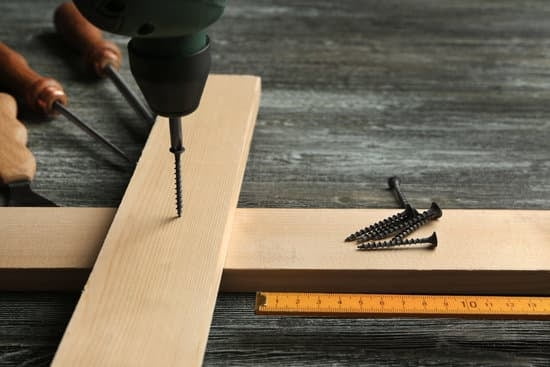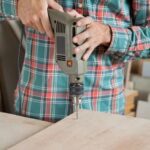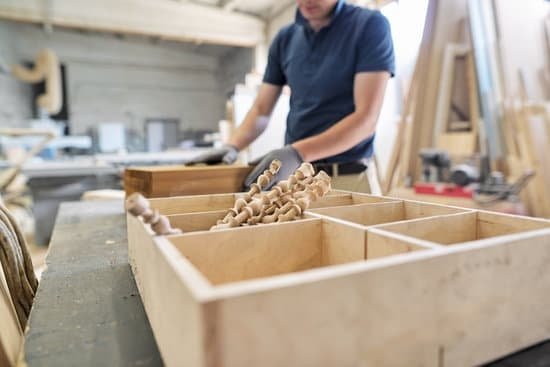Introduction
Using the right tools is essential for all woodworking projects, and one of the most important is a good quality woodworking square. This type of square is used to ensure measurements are accurate when creating angles and cutting perpendicular lines. It’s also used in lay-out work to check that joints have been properly positioned and squared off.
Woodworking squares come in different types, sizes and shapes, making them ideal for any project, big or small. The most common are the standard carpenters square, combination squares, try squares and bevel squares.
Carpenters Squares – Carpenters squares look like an oversized ruler with a perpendicular lip on one side. These are versatile tools that can help draw lines accurately at 90 degrees from each other ” perfect for marking along the edges of plywood or hardwood planks. They are usually constructed from stainless steel for extra durability.
Combination Squares – Combination squares combine several functions in one tool: A 12 inch or 6 inch ruler, plus a center finder head for finding the exact middle between two points; level vial bubbles; and both a standard angle scribe and angle finder head for duplication of existing angles or construction of special angles, such as cutting miter joints correctly.
Try Squares – Try squares are smaller than carpenter’s squares as they typically measure four inches by three inches (or less). They look more like traditional rulers with an angled face which makes it easy to draw a straight line along any edge of the workpiece. They are great for checking table saw blade cuts now that they have been made to make sure they are straight.
Bevel Squares – Bevel squares feature a thin blade attached to a handle at an adjustable angle ” anywhere from 0° to 90° angle ” depending on what you need to measure or cut out of your material. Other features may include various scales such as degrees, millimeters or centimeters depending on how precise you need your measurements or cuts to be. Beveled try squares can also serve as both flush trimming tool and chisel guide when shaping wood edges by hand with chisels and planes
Types of Woodworking Squares
There are several types of woodworking squares available to choose from, depending on your needs and preferences. Commonly used squares include the combination square, speed square, bevel square, try square, sliding T-bevel, and framing square.
The combination square is designed to do more than just measure right angles; it also has a ruler along its length for measuring and marking straight lines. The speed square is constructed with an adjustable and movable locking bolt which can be used for securing against irregular surfaces for improved accuracy. The bevel square features a blade that can be moved at any angle from 0 to 360° as well as a scribe line maker that enables accurate marking angle measurements.
The try square is composed of two blades joined with a riveted metal strip that forms the handle. This type of woodworking tool is typically used when precise 90° angles need to be tested such as when making picture frames or drawers with dovetail joints. Another popular woodworking tool is the sliding T-bevel which has a blade set between two pivoting arms that hold it in place at any desired angle for measuring or transferring angles onto or between objects. Finally, the framing square features large size graduations marked onto thick metal plates along both the head which holds inside and outside dimensions measurements up to Fifteen inches apart; this makes it particularly great for quick measurements of longer distances on construction projects like outlining walls or flooring panels.
Benefits of Using Woodworking Squares
Woodworking squares are invaluable tools for any woodworking project. Whether you’re building a furniture piece or constructing frames, these tools will provide the precision and accuracy of measurements that you need. By ensuring that all the lines and angles are square, carpentry projects are much easier to undertake and complete. Here are some advantages of owning a quality woodworking square:
Accuracy- Woodworking squares allow you to measure accurately, allowing any project to turn out perfectly in regards to shape. The accuracy of measurements is extremely important in every aspect of carpentry, from creating uniform structural shapes to producing aesthetically pleasing designs.
Precision- A good woodworking square will ensure that all elements of the project remain precise, from each individual measurement down to the overall structure or design being created. When measuring angles and lines with woodworking squares, your results will be exact each time.
Durability – Quality woods crafting squares can withstand wear and tear over time in ways that cheap models cannot. This makes them a worthwhile investment for novice or experienced crafters alike as their investment won’t deteriorate quickly through use or age.
Ergonomics- Investing in a good squared designed specifically with ergonomics in mind helps to reduce fatigue while working on complex projects. The handle should be comfortable while still providing a secure grip and strong support even when used for prolonged periods of time with hard materials such as hardwoods . Additionally, it should be able to fit comfortably into any hand size with minimal effort required from the craftsmen due to its construction from lightweight yet high-grade materials such as aluminum or steel.
How to Choose the Right Woodworking Square
When it comes to woodworking, having the right tools is essential. One such tool is a woodworking square that offers accuracy and ensures your cuts are straight and accurate. When you are looking for the best woodworking squares, there are a few factors you should consider before making your purchase.
Firstly, you need to decide how much accuracy you need from your woodworking square. There are both combination squares, which provide sufficient accuracy for most jobs and machinist’s squares which offer greater precision than combination squares. Consider what projects you will be using it for, as well as the accuracy of any other tools in your kit ” if they are inaccurate, it won’t make much difference whether you have a combination or machinist’s square.
You should also consider the material the square is made from. Most companies use stainless steel for their machinist’s squares, due to its resilience and longevity, but cast iron may last longer under tough conditions. Not all combination squares are created equal; some suggest cheaper materials like aluminum which can be damaged more easily over time.
Finally, think about what size woodworking square would work best for your needs ” larger squares with wider blades make it easier to mark off wider angles or cuts but can be hard to adjust with one hand whilst keeping your measurements even. Smaller versions are easier to manoeuvre around smaller spaces, but could slow down project times when working on larger pieces of work.
Choosing the right woodworking square depends on many factors; considering these things before buying one can help ensure that you get a quality product that offers great results no matter what project you undertake!
Tips on Using Woodworking Squares
Using a woodworking square is essential for any woodworker, but there are a few tips to bear in mind when you’re looking to get the best performance and results. Firstly, it’s important to make sure that your woodworking square is true; check the edges and corners with other tools such as rulers and standard squares to make sure that they are accurate, since any inaccurate readings could throw off all of the measurements you take afterwards. It also helps to regularly clean off your woodworking square – dust, debris, or even grime can reduce accuracy and lead to sloppy results. Finally, if you’re working with different materials or projects involving curves, consider investing in a specialized combination square that offers an attachment for measuring angles. This can help ensure you have the right measurement for any shape or angle without having to guess from visual cues. By following these simple pro-tips when using your woodworking square, you’ll be able to work faster and more accurately while avoiding extra waste due to inaccurate measurements!
Best Woodworking Squares
When it comes to woodworking, accuracy is essential for successful projects. A woodworker needs the best woodworking squares to make sure that their work is precise and well-executed. The accuracy and precision of a square will determine the outcome of your project, from aligning mitered joints to cutting straight lines. It’s therefore essential for anyone who works with wood to be familiar with the different types of squares available on the market and know what features they should look for in a quality tool.
There are different kinds of squares used in woodworking, both manual and digital. Manual squares include try squares, miter boxes, combination squares, sliding T-bevels, framing squares and beam compasses. Try Squares are the most basic kind ” they are used to determine angles along an edge or board surface. Miter boxes are used for creating angled cuts on smaller workpieces like moldings or baseboards and come in adjustable lengths for various projects. Combination Squares consist of two parts – an adjustable locking head that slides along a 12 inch ruler allowing you to measure inside or outside dimensions of corners or edges accurately. Sliding T-Bevels feature blades that can pivot left or right up to 45 degrees making them ideal for marking out any kind of angle with relative ease. Framing Squares are bigger overall than other traditional hand squaring tools ” they usually have 16” bodies with 24” arms which allow marks across wide boards without moving your position unnecessarily at any given time. Beam Compasses offer big circles and arcs but also have protractors which facilitate layout work faster since you don’t need separate tools anymore and marking out circles is much easier as a result.
Digital versions include laserlyte levels that project laser beams over walls in order to check levelness and squareness quickly; digital angle finders capable of giving users a numerical output that corresponds directly to the exact angle measured with its markings incredibly accurate; electronic robotic total stations particularly useful when working on large areas offering laser precision between multiple points such as for roof pitches etc; 4th axis rotary tables (edgefinder) enabling intricate 3D contours via CNC machines; dedicated software solutions like SquareONE delivering CAD drawings from single scans providing distances measurements area calculations etc ready for print out at virtually any scale required.; and finally CMM machines built specifically tailored around testing jobs being particularly useful when working on tighter tolerances applications verifying planes flatness or perpendicularity between surfaces completely automatically up against required ISO references if needed by various production sectors.
As you can see, there’s plenty of choices out there right now when it comes down to choosing what kind of square would best suit one individual set of requirements so it’s important that you do adequate research prior making an informed decision!
Conclusion
Woodworking squares are essential tools for any woodworker. They provide precision and accuracy in measuring and cutting materials with ease. Investing in a quality woodworking square will go a long way in improving the craftsmanship of any project. These devices have benefits over other kinds of rulers, levels, and other devices used for rough measurements.
Woodworking squares are designed to help you measure accurately and quickly. These units are designed to make sure that each angle is exactly 90º so that everything is cut evenly. Not only does this make the cuts accurate but it ensures consistency across projects which has very definite value in professional carpentry or furniture making where tight tolerances are key to success. With a good woodworking square, there’s no guesswork needed, so even a novice can take on DIY projects without fear of failure. Additionally, they come in several sizes so you get the right sized piece for each job.
The benefit of using woodworking squares don’t end here! The ability to measure angles and distances makes it easier to mark multiple cuts at once, saving time and reducing potential mistakes when cutting wood by hand or with power tools like saws or routers. Not just that, having a good square makes it easier to fit large pieces together smoothly and accurately too while assembling the pieces after construction is complete. Moreover, squaring off boards before nailing them together helps ensure tight joints that won’t separate over time.
In conclusion, investing in a quality woodworking square is well worth it for any craftsman as these straight edges pay for themselves with their enhanced accuracy and convenience in measuring anything from small pieces of wood to large lumber projects. With the ability to mark out precise angles as well as making fast work of measuring distances between points not just on one edge but two perpendicular edges at once – having an accurately made square becomes indispensable tool which no aspiring craftsman should be without!

Hi everyone! I’m a woodworker and blogger, and this is my woodworking blog. In my blog, I share tips and tricks for woodworkers of all skill levels, as well as project ideas that you can try yourself.





